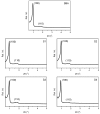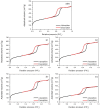Anticancer Applications of Nanostructured Silica-Based Materials Functionalized with Titanocene Derivatives: Induction of Cell Death Mechanism through TNFR1 Modulation
- PMID: 29385103
- PMCID: PMC5848921
- DOI: 10.3390/ma11020224
Anticancer Applications of Nanostructured Silica-Based Materials Functionalized with Titanocene Derivatives: Induction of Cell Death Mechanism through TNFR1 Modulation
Abstract
A series of cytotoxic titanocene derivatives have been immobilized onto nanostructured silica-based materials using two different synthetic routes, namely, (i) a simple grafting protocol via protonolysis of the Ti-Cl bond; and (ii) a tethering method by elimination of ethanol using triethoxysilyl moieties of thiolato ligands attached to titanium. The resulting nanostructured systems have been characterized by different techniques such as XRD, XRF, DR-UV, BET, SEM, and TEM, observing the incorporation of the titanocene derivatives onto the nanostructured silica and slight changes in the textural features of the materials after functionalization with the metallodrugs. A complete biological study has been carried out using the synthesized materials exhibiting moderate cytotoxicity in vitro against three human hepatic carcinoma (HepG2, SK-Hep-1, Hep3B) and three human colon carcinomas (DLD-1, HT-29, COLO320) and very low cytotoxicity against normal cell lines. In addition, the cells' metabolic activity was modified by a 24-h exposure in a dose-dependent manner. Despite not having a significant effect on TNFα or the proinflammatory interleukin 1α secretion, the materials strongly modulated tumor necrosis factor (TNF) signaling, even at sub-cytotoxic concentrations. This is achieved mainly by upregulation of the TNFR1 receptor production, something which has not previously been observed for these systems.
Keywords: TNFR1 modulation; anticancer; cytotoxicity; nanostructured silica; titanocene; tumor necrosis factor.
Conflict of interest statement
The authors declare no conflict of interest.
Figures











Similar articles
-
Modulation of the mechanism of apoptosis in cancer cell lines by treatment with silica-based nanostructured materials functionalized with different metallodrugs.Dalton Trans. 2018 Sep 11;47(35):12284-12299. doi: 10.1039/c8dt01677a. Dalton Trans. 2018. PMID: 30112529
-
Anti-cancer applications of titanocene-functionalised nanostructured systems: an insight into cell death mechanisms.Chemistry. 2014 Aug 18;20(34):10811-28. doi: 10.1002/chem.201400300. Epub 2014 Apr 8. Chemistry. 2014. PMID: 24715574
-
Improvement of cytotoxicity of titanocene-functionalized mesoporous materials by the increase of the titanium content.Dalton Trans. 2010 Mar 14;39(10):2597-608. doi: 10.1039/b920051g. Epub 2010 Jan 27. Dalton Trans. 2010. PMID: 20179853
-
Antitumour bis(cyclopentadienyl) metal complexes: titanocene and molybdocene dichloride and derivatives.Dalton Trans. 2007 Aug 28;(32):3474-82. doi: 10.1039/b707440a. Epub 2007 Jul 20. Dalton Trans. 2007. PMID: 17680034 Review.
-
Mechanisms of cytotoxicity of anticancer titanocenes.Anticancer Agents Med Chem. 2010 May;10(4):302-11. doi: 10.2174/187152010791162261. Anticancer Agents Med Chem. 2010. PMID: 20380637 Review.
Cited by
-
A Review of Silica-Based Nanoplatforms for Anticancer Cargo Delivery.Int J Mol Sci. 2025 Jun 18;26(12):5850. doi: 10.3390/ijms26125850. Int J Mol Sci. 2025. PMID: 40565310 Free PMC article. Review.
-
HRG switches TNFR1-mediated cell survival to apoptosis in Hepatocellular Carcinoma.Theranostics. 2020 Aug 20;10(23):10434-10447. doi: 10.7150/thno.47286. eCollection 2020. Theranostics. 2020. PMID: 32929358 Free PMC article.
-
Applications of Nanomaterials Based on Magnetite and Mesoporous Silica on the Selective Detection of Zinc Ion in Live Cell Imaging.Nanomaterials (Basel). 2018 Jun 14;8(6):434. doi: 10.3390/nano8060434. Nanomaterials (Basel). 2018. PMID: 29903996 Free PMC article.
-
Biological Use of Nanostructured Silica-Based Materials Functionalized with Metallodrugs: The Spanish Perspective.Int J Mol Sci. 2023 Jan 25;24(3):2332. doi: 10.3390/ijms24032332. Int J Mol Sci. 2023. PMID: 36768659 Free PMC article. Review.
-
Multifunctional Silica-Based Nanoparticles with Controlled Release of Organotin Metallodrug for Targeted Theranosis of Breast Cancer.Cancers (Basel). 2020 Jan 12;12(1):187. doi: 10.3390/cancers12010187. Cancers (Basel). 2020. PMID: 31940937 Free PMC article.
References
-
- Rosenberg B., Camp L.V. The successful regression of large solid sarcoma 180 tumors by platinum compounds. Cancer Res. 1970;30:1799–1802. - PubMed
LinkOut - more resources
Full Text Sources
Other Literature Sources
Miscellaneous

